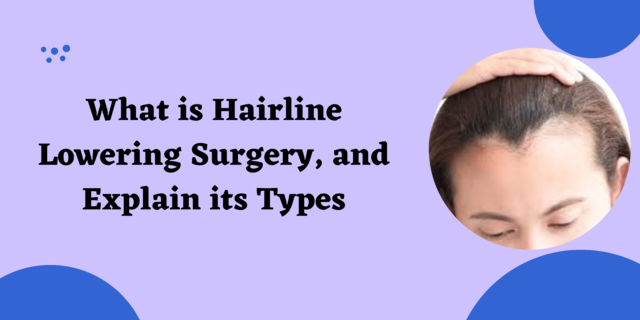In general, individuals want to have a hairline that matches the shape of their faces. One’s self-esteem might suffer from a vast forehead or a high hairline, making them feel self-conscious and uncomfortable. A broad forehead or a receding hairline may be caused by hereditary factors, hair loss, or previous surgery. The hairline lowering surgery technique is available to both men and women, and the benefits are instant and sweeping.
What is hairline thinning?
If you’d want to lower your hairline or lessen the appearance of your forehead, this surgery is for you. The procedure aims to reduce the gap between the hairline and the brows by two to three centimeters (cm). As a result, the hairline seems more symmetrical, and the entire face appearance is improved. However, the surgeon considers several variables while arranging the procedure. Hairline hair thickness, scalp flexibility, hairline height, past surgery, and so on are all factors to consider.
Many healthy-looking men and women with thick hairlines might benefit from this surgery.
Other characteristics, such as flexibility of the scalp and forehead skin, and quality of hair at the hairline, will also play a role in determining whether or not you are an excellent candidate for this operation.
Types-
Hairline Advancement:
Surgical lowering hairline transplant palm desert advancement or a hair grafting surgery that removes 2-3 cm of skin from the hairline may lower the hairline. Skin is removed and then sewn back up on a pulled-down scalp. The incision scar is not visible once the skin has been sutured, and the hairline will ultimately cover it up after the hair comes back.
Hair-Grafting:
With hair grafting, a receding hairline may be re-established. Extracted from the donor location, which is often the rear of the head, these hair follicles are then transplanted into small incisions created in front of your current hairline, similar to a hair transplant.
Before hairline reduction surgery, there are several precautions to consider
- Avoid consuming alcohol, which may lead to fluid retention and edema, and eat a low-salt diet.
- Make an appointment with your doctor and devise a nutrition plan to help your body fight against infection and prepare you for surgery.
- In addition, your surgeon will provide you with instructions on avoiding infection and blood clots after surgery.
- Anti-inflammatory medications should be avoided for a week before surgery since they may slow or impede healing.
Most hairline lowering surgery procedures don’t need two sessions unless tissue growth is required as part of the operation. It takes 7-10 days to recover fully.
Temporary consequences of surgery to decrease the hairline
As with other procedures, hairline reduction surgery comes with several potential complications.
- There may be some edema or inflammation surrounding the treatment area: The following are examples of short-term adverse effects:
- Around the surgical incision, there may be some bleeding. Applying an ice pack to the inflamed area is the most excellent technique to reduce swelling. On the other hand, if you take extreme care after surgery, most of these side effects may be avoided or will go away on their own.
Numbness:
After lowering hairline transplant palm desertsurgery, it is typical for the forehead to be numb. The numbness resolves typically within three to five days on its own.
Removing your receding hairline could cost you more or less money, depending on where you live.
- For at least 14 days, avoid intense activity and heavy lifting.
- Apply ice to any part of your body that is swollen or hurting after surgery. It’s possible to get a prescription for painkillers from your doctor and follow up instructions.
- One week following surgery, refrain from smoking or drinking alcoholic beverages to hasten your recovery.
- Eat a diet high in vitamin C to speed up the healing process.
Do You Know What You Can Expect From A Hairline Lowering?
Most cosmetic operations are geared toward making individuals seem more attractive. As a result, the expectations of a person receiving a cosmetic surgery operation like hairline reduction are typically unrealistic.
There are two ways to reduce a person’s hairline: removing the top layer of the skin and using an expander. You may anticipate the ‘after-procedure’ appearance to be the most realistic expectation from hairline lowering surgery. Post-procedure images’ one-dimensional view of surgery might sometimes be misleading and deceiving. Speak with others who have already had the procedure to obtain a realistic perspective on the results. You may also learn about different hairline lowering outcomes through patient testimonies.
If you have a prominent forehead and are concerned about scarring, you should not get this procedure. Also, because of the length of the hairline scar, those prone to scarring or whose skin is difficult to recover from scars should reconsider the operation.
Concluding
To lessen the size of one’s forehead, lowering hairline transplant palm desert surgery shifts the hairline downward. Often referred to as a forehead lift, this operation reduces the scalp to enhance face proportions. Swelling, bleeding, and a tingling sensation around the surgical site are all expected following the procedure, although these symptoms will diminish with time.
Author Bio:
Naman Modi is a Professional Blogger, SEO Expert & Guest blogger at Beverly Hills Hair Restoration. He is an Award-Winning Freelancer & Web Entrepreneur helping new entrepreneurs launch their first successful online business.
Social Media Links:-
https://www.facebook.com/BeverlyHills.HairRestoration
https://www.instagram.com/beverlyhillshairrestoration/
https://www.linkedin.com/company/beverly-hills-hair-restoration







